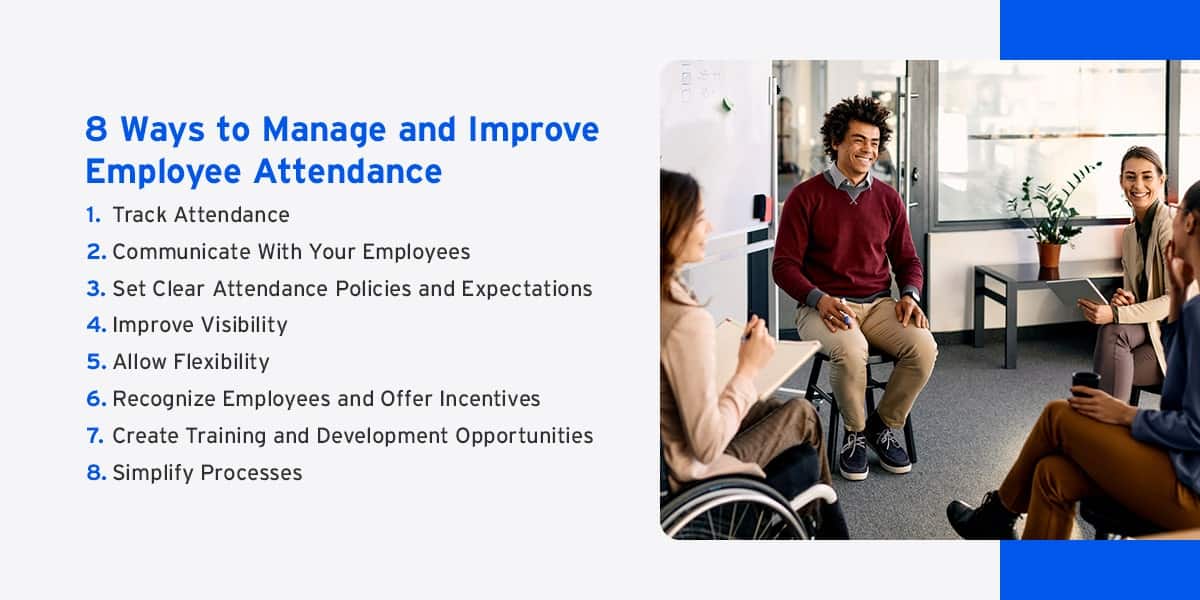Managing and improving employee attendance goes beyond simply tracking hours worked and addressing absences. It involves creating an environment that promotes attendance excellence, motivates employees to prioritize attendance, and provides the necessary support to overcome attendance-related challenges. With the right approaches, managers can cultivate a high-performance workforce and establish a foundation for success.
This article will look at how to manage employee attendance by providing valuable insights into various aspects of attendance management. Some of these aspects include how essential employee attendance is and the role of technology in streamlining attendance processes. Creating a work environment that fosters attendance excellence, enhances productivity, and drives organizational success is just a few paragraphs away.
The Importance of Employee Attendance
By recognizing its significance and implementing robust attendance management strategies, managers and directors can enhance productivity and cultivate a positive work culture. Here’s why employee attendance is important.
Promotes Productivity and Performance
When employees consistently attend work as scheduled, they contribute to the smooth functioning of essential business operations. Regular attendance allows for the timely completion of tasks, the meeting of deadlines, and the execution of projects without unnecessary disruptions.
Ensures Consistency and Reliability
Consistency and reliability are qualities that underpin the success of any organization. When employees are consistently present at work, it instills a sense of dependability and reliability. Customers, clients, and other stakeholders develop trust in a business when they can rely on its employees to be present and available to serve their needs.
Enhances Team Collaboration and Communication
Employee attendance plays a pivotal role in facilitating effective team collaboration and communication. When physically present, team members can engage in face-to-face interactions, share ideas, seek feedback, and resolve issues promptly. Active participation through attendance fosters stronger relationships among team members, boosts morale, and enhances teamwork.
Reduces Costs and Workplace Disruptions
Absenteeism can have a significant impact on a company’s bottom line. When employees are frequently absent, it often leads to increased costs due to the need for temporary replacements, overtime pay, or delays in project completion. Moreover, absenteeism disrupts workflow, causing bottlenecks and hindering progress. By effectively promoting and managing employee attendance, managers can mitigate these issues, minimize costs, and maintain a streamlined workflow that allows optimal resource allocation.
Cultivates a Positive Work Culture
Employee attendance is closely tied to the overall work culture of an organization. Employees who consistently attend work feel a sense of belonging, motivation, and engagement, leading to increased job satisfaction. This positive work culture, fostered by attendance management, contributes to higher employee retention rates and attracts top talent to the organization.

8 Ways to Manage and Improve Employee Attendance
Effective management and improvement of employee attendance require a comprehensive approach that includes clear policies, flexible work arrangements, and reliable tracking systems, among other things. By implementing these strategies, managers and directors can foster a culture of attendance excellence that contributes to the organization’s overall success. Learn how to manage the attendance of employees with the following tips.
1. Track Attendance
Implementing automated systems that accurately record employees’ work hours, track leave requests, and provide real-time attendance data can streamline attendance management processes. These systems ensure accuracy and reduce the administrative burden associated with manual tracking, allowing managers to identify attendance patterns and address issues promptly.
2. Communicate With Your Employees
Figuring out what is the best way to improve employee attendance starts with a good communication foundation. Regularly communicate the importance of attendance, update attendance records, and offer feedback on individual attendance performance. Engage in constructive conversations with employees to understand any underlying issues impacting their attendance and offer support or resources to help address those challenges. Managers can proactively address attendance concerns and motivate employees to prioritize attendance by fostering a positive communication and feedback culture.
3. Set Clear Attendance Policies and Expectations
Establishing clear attendance policies and communicating them effectively to employees is the foundation for managing attendance. Clearly outline expectations regarding punctuality, absences, tardiness, and procedures for reporting time-off requests. Ensure these policies are easily accessible to all employees through employee handbooks, intranet portals, or other relevant communication channels. By setting clear guidelines, employees will understand how essential attendance is and the consequences of non-compliance.
4. Improve Visibility
One effective way to improve attendance visibility and empower employees is by incorporating technology, allowing convenient access to schedules from their mobile devices. By embracing this digital approach, managers and directors can give employees real-time access to their schedules, fostering transparency and flexibility.

5. Allow Flexibility
Knowing how to improve employee attendance is to recognize the diverse needs of your workforce and consider implementing flexible work arrangements, such as remote work options or flexible scheduling. Allowing employees to adjust their work hours or work remotely can help them manage personal obligations while maintaining a commitment to attendance. Flexible arrangements demonstrate a willingness to accommodate employees’ needs, leading to increased job satisfaction and reduced absenteeism.
6. Recognize Employees and Offer Incentives
Recognizing and rewarding employees who consistently demonstrate exemplary attendance can be a powerful motivator. Implement an employee recognition program that acknowledges individuals with exceptional attendance records. Recognition can include monetary rewards, additional time off, or public announcements. Celebrating good attendance reinforces the value placed on attendance and encourages other employees to strive for improved attendance.
7. Create Training and Development Opportunities
Investing in employees’ professional growth through training and development opportunities can positively impact attendance. Providing employees with opportunities to enhance their skills and knowledge increases job satisfaction and fosters a sense of commitment and loyalty. Employees who feel valued and invested are more likely to maintain regular attendance and actively contribute to the organization’s success.
8. Simplify Processes
Managers and directors can create a seamless employee experience while efficiently managing attendance by simplifying key processes, such as the time-off request process. Managers and directors empower employees to take ownership of their attendance while minimizing administrative burdens by ensuring a user-friendly time-off request process.
Simplify Attendance Management With Indeavor
Learning how to improve employee attendance problems starts by prioritizing attendance. By making this an objective, managers and directors can enhance productivity, foster a positive work culture, and reduce costs. Implementing clear attendance policies, flexible work arrangements, and proactive problem-solving can significantly improve attendance rates and overall employee engagement.
To further simplify attendance management and streamline workforce scheduling in industrial environments, we recommend exploring the solutions offered by Indeavor. Our purpose-built shift schedule automation solution is designed specifically for industrial organizations, considering factors such as demand, employee population, and work rules. With intelligent algorithms that handle even the most complex workforces, Indeavor offers a comprehensive solution that automates the scheduling process.
Indeavor’s customer support is highly regarded, providing best-in-class service and support to clients. We ensure a personalized approach, designing customized key performance indicators (KPIs) for each client and providing monthly reports to track progress and optimize workforce management with a dedicated customer success manager.
By leveraging Indeavor’s People Operations Platform, industrial enterprises can digitize and streamline their entire scheduling process, eliminating the need for manual methods. Indeavor offers a rapid and efficient implementation process, allowing organizations to experience the benefits of their solution with a setup time of fewer than three months.
Book a Demo Today
To learn more about Indeavor and its innovative solutions, we encourage you to book a demo with our team. Discover how our technology can transform attendance management and scheduling processes, optimize workforce engagement, and drive operational efficiency. Say goodbye to outdated scheduling methods and embrace the power of automation with Indeavor’s industry-leading platform.







